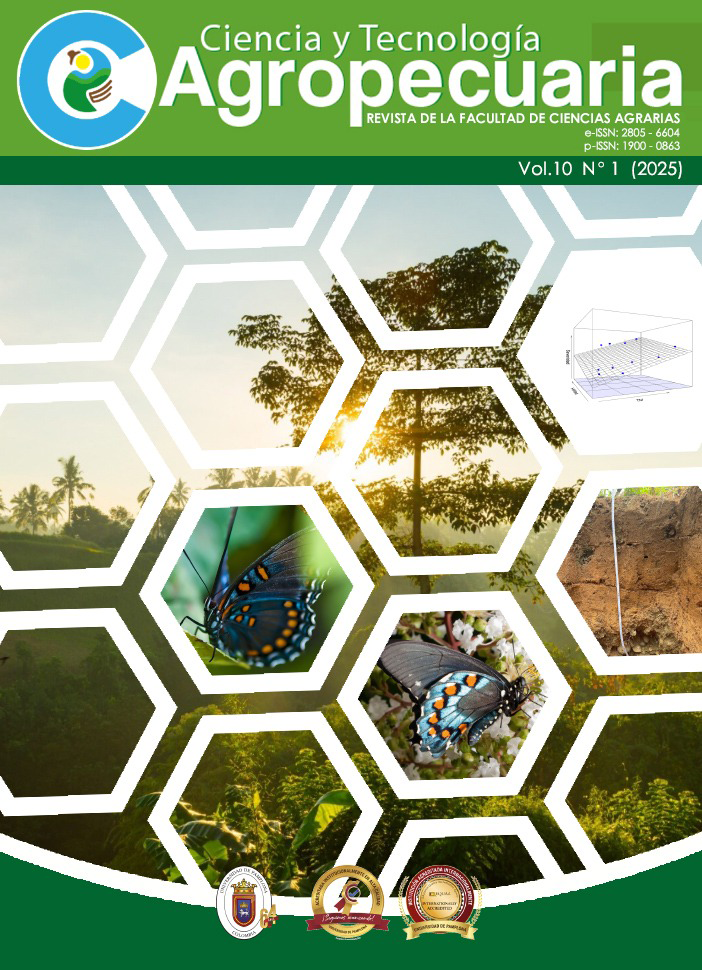Mariponasa: Transforming butterfly larval feces into biofertilizer
DOI:
https://doi.org/10.24054/cyta.v10i1.3648Keywords:
Organic fertilization, entomofauna, butterfliesAbstract
Biofertilizers made from animal manure represent a sustainable and environmentally friendly alternative to conventional chemical fertilizers. This practice enables the utilization of animal by-products to enhance soil fertility. In addition to supplying essential nutrients, these biofertilizers promote beneficial microbial activity, which helps improve soil structure and optimize nutrient availability for plants. In this regard, it was considered to analyse the feces of four species of butterfly larvae, namely: Battus polydomas, Metemorpha elissa, Methona confusa, Hamadryas, to determine whether they can be considered as organic manure or biofertilizer. The microbiota of the samples of mariponase were also characterized, these were sown in selective and nutritive medium PCA, Agar Czapek and Agar Mac Conkey, also subjected to biochemical tests SIM, TSI and LYSINE, in addition, Gram staining was performed to identify and characterize the microorganisms present. The results showed high concentrations of aerobic mesophiles and a notable presence of nitrifying bacteria and enterobacteria, with Enterobacter cloacae and Klebsiella pneumoniae identified as the predominant species, Gram staining confirmed the presence of Gram-negative bacilli.
Downloads
References
Akhi, M. T., Ostadgavahi, A. T., Ghotaslou, R., Asgharzadeh, M., Pirzadeh, T., Sowmesarayi, V. S., & Memar, M. Y. (2015). Detection, Virulence Gene Assessment and Antibiotic Resistance Pattern of O157 Enterohemorrhagic Escherichia coli in Tabriz, Iran. Jundishapur Journal of Microbiology, 8(11), https://doi.org/10.5812/jjm.25317. DOI: https://doi.org/10.5812/jjm.25317
Atlas, R. M. (1993). Handbook of microbiological media. Boca Raton: CRC Press.
Becerra, S. C., Roy, D. C., Sanchez, C. J., Christy, R. J., & Burmeister, D. M. (2016). An optimized staining technique for the detection of Gram positive and Gram negative bacteria within tissue. BMC Research Notes, 9 (1), 1 - 10. https://doi.org/10.1186/s13104-016-1902-0. DOI: https://doi.org/10.1186/s13104-016-1902-0
Clark, D. P., Martinko, J. M., Madigan, M. T., & Dunlap, P. V. (2009). Brock. biología de los microorganismos. España: Editorial Pearson.
Daniel, A., Adewale, O., Fadaka, Gokul, A., Bakare, O., Aina, O., Fisher, S., Burt, A., Mavumengwana, V., Keyster, M., & Klein, A. (2022). Biofertilizer: The Future of Food Security and Food Safety. Microorganisms, 10, 1220. https://doi.org/10.3390/microorganisms10061220. DOI: https://doi.org/10.3390/microorganisms10061220
Díaz Pérez, M., Rodríguez Martínez, C., & Zhurbenko, R. (2013). Enterococcus, medios de cultivo convencionales y cromogénicos. Revista Cubana de Higiene y Epidemiología, 51 (1), 97-110.
Gurusinghe, S., Brooks, T. L., Barrow, R. A., Zhu, X., Thotagamuwa, A., Dennis, P. G., Gupta, V. V. S. R., Vanniasinkam, T., & Weston, L. A. (2019). Technologies for the Selection, Culture and Metabolic Profiling of Unique Rhizosphere Microorganisms for Natural Product Discovery. Molecules (Basel, Switzerland), 24(10), 1955. https://doi.org/10.3390/molecules24101955. DOI: https://doi.org/10.3390/molecules24101955
Holt, J. G. (1994). Bergey’s Manual of Determinative Bacteriology. United States of America: Lippincott Williams & Wilkins.
Houbraken, J., Kocsubé, S., Visagie, C. M., Yilmaz, N., Wang, X.-C., Meijer, M., Kraak, B., Hubka, V., Bensch, K., Samson, R. A., & Frisvad, J. C. (2020). Classification of Aspergillus, Penicillium, Talaromyces and related genera (Eurotiales): An overview of families, genera, subgenera, sections, series and species. Studies in Mycology, 95, 5-169. https://doi.org/10.1016/j.simyco.2020.05.002. DOI: https://doi.org/10.1016/j.simyco.2020.05.002
Kumar, A., Moond, V., Choudhari, R., Badekhan, A., Tejasree, P., Baral, K., & Bharti, R. (2024). Optimizing Bio-fertilizers to Address Food Security and Advance Nutritional Sustainability. Journal of Experimental Agriculture International, 45 (2). https://doi.org/10.9734/JEAI/2023/v45i122284. DOI: https://doi.org/10.9734/jeai/2023/v45i122284
Kumar, S., Panghal, V. P., Narender, & Kumar, S. (2023). Effect of Organic Manures and Natural Farming on Soil Properties and Nutrient Uptake by Carrot. International Journal of Plant & Soil Science, 35 (21), 1172-1177. https://doi.org/10.9734/ijpss/2023/v35i214089. DOI: https://doi.org/10.9734/ijpss/2023/v35i214089
Lara, C., Sanes, S. C., & Oviedo, L. E. (2013). Impacto de bacterias nativas solubilizadoras de fosfato en el crecimiento y desarrollo de plantas de rábano (Raphanus sativus L.). Biotecnología Aplicada, 30 (4), 271-275.
Lara, C. L., Villalba, M., & Oviedo, L. E. (2007). Bacterias fijadoras asimbióticas de nitrógeno de la zona agrícola de San Carlos. Córdoba, Colombia. Revista Colombiana de Biotecnología, IX (2), 6-14.
Mehata, D., Kattel, I., Sapkota, P., Ghimire, N., & Mehta, R. (2023). Biofertilizers: A sustainable strategy for organic farming that would increase crop production and soil healtH. Plant Physiology and Soil Chemistry, 3, 49-53. https://doi.org/10.26480/ppsc.02.2023.49.53. DOI: https://doi.org/10.26480/ppsc.02.2023.49.53
Mosavian, M., & Koraei, D. (2016). Molecular Detection of IMP Carbapenemase-Producing Gram-Negative Bacteria Isolated From Clinical Specimens in Ahvaz, Iran. Jentashapir Journal of Health Research, 7(6). https://doi.org/10.17795/jjhr-36394. DOI: https://doi.org/10.17795/jjhr-36394
Nour El-Din, M., & Salem, A. (2015). Response of two wheat varieties to biofertilization and organic agriculture system on yield and infestation with Rhizopertha dominica during storage. Journal of Plant Protection and Pathology, 6 (1), 73-84. https://doi.org/10.21608/jppp.2015.53079. DOI: https://doi.org/10.21608/jppp.2015.53079
Qiu, Z., Paungfoo-Lonhienne, C., Ye, J., Gonzalez, A., Petersen, I., Di Bella, L., Hobbs, R., Ibanez, M., Heenan, M., Wang, W., Reeves, S., & Schmidt, S. (2022). Biofertilizers can enhance nitrogen use efficiency of sugarcane. Environmental Microbiology, 24(8), 3655-3671. https://doi.org/10.1111/1462-2920.16027. DOI: https://doi.org/10.1111/1462-2920.16027
c, R., & Babalola, O. (2021). Utilization of Microbial Consortia as Biofertilizers and Biopesticides for the Production of Feasible Agricultural Product. Biology, 10 (11), 1111. https://doi.org/10.3390/biology10111111. DOI: https://doi.org/10.3390/biology10111111
Silva, F., & Martínez, T. P. (2018). Complejo Enterobacter cloacae. Revista Chilena de Infectología, 35 (3), 297-298. https://doi.org/10.4067/s0716-10182018000300297. DOI: https://doi.org/10.4067/s0716-10182018000300297
Talwar, D., Singh, K., & Singh, J. (2017). Effect of biofertilizers on soil microbial count, nutrient availability and uptake under november sown onion. Journal of Applied and Natural Science, 9 (1), 55- 59. https://doi.org/10.31018/jans.v9i1.1149. DOI: https://doi.org/10.31018/jans.v9i1.1149
Thomson, K. (2003). World agriculture: Towards 2015/2030. Land Use Policy, 20, 375. https://doi.org/10.1016/S0264-8377(03)00047-4. DOI: https://doi.org/10.1016/S0264-8377(03)00047-4
Torriente, D. (2010). Revisión bibliográfica. Aplicación de bacterias promotoras del crecimiento vegetal en el cultivo de la caña de azúcar. perspectivas de su uso en Cuba. Cultivos Tropicales, 31(1), 19-26.
Downloads
Published
How to Cite
Issue
Section
License
Copyright (c) 2025 Lady Carolina Castañeda Bata, Luz Dary Pedraza Hernández, Hebandreyna González García, Joan Sebastian Gracia Rojas, Tatiana Navarro Tamayo

This work is licensed under a Creative Commons Attribution-NonCommercial-ShareAlike 4.0 International License.










